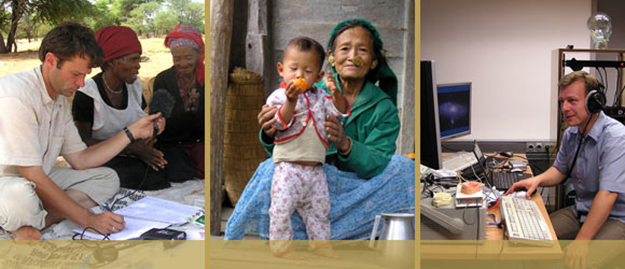Former Department of Linguistics

The Department of Linguistics existed from 1998 to 2015 under the leadership of Bernard Comrie. It studied the diversity of human language and the historical processes underlying this diversity. The researchers were interested in “language universals”, i.e. properties that are common to all human languages, and “language typology”, i.e. properties in which languages differ from each other. Why are language universals and cross-linguistic variation the way they are? To this end, various phenomena across a wide range of languages were studied, and reference was made to formal properties of language, to the cognitive bases of languages, and to aspects of language in use. Both grammatical and lexical features were investigated, taking into account regional peculiarities, therefore, field work was an important tool of the department’s linguistic research.
Mission
The Department of Linguistics investigated the diversity of human language and the historical processes underlying this diversity.
Diversity of Human Language
We were interested in finding out what properties are common to all human languages (“language universals”) and the ways in which languages can differ from each other (“linguistic typology”). Beyond this, we aimed to answer the question why language universals and cross-linguistic variation are the way they are. To this end, we studied various phenomena across a wide range of languages. Our work made reference to formal properties of language, to the cognitive bases of language, and to aspects of language in use.
As part of our work on the cross-linguistic study of various phenomena, we also worked on the descriptive grammars of various little studied, and often endangered, languages. Today about 6,500 languages are spoken world-wide, most of them are endangered. A quarter of these languages have fewer than 1,000 speakers, and many of them are already moribund (no longer learnt by children). To preserve or at least document as many languages as possible, members of the department investigated indigenous languages across the world. They spent extended periods of time in the area where the language is spoken, worked on descriptive grammars, compiled dictionaries, and collected texts.
Children are able to learn any human language provided they grow up in the appropriate linguistic and social environment. In collaboration with the Department of Psychology, we studied whether children learning different languages use the same learning strategies or whether their strategies differ according to the linguistic environment in which they grow up.
Historical Processes
We were interested in the ways in which linguistic evidence can be used, often together with evidence from other fields, to provide solutions to problems of human prehistory. As part of this investigation, we also studied comparable contemporary situations to provide a basis for more detailed modeling of earlier times.
Particular problems on which we were engaged include the establishment of the "family tree" of the world’s languages, i.e. the extent to which it can be shown that particular languages (a “language family”) descend from a single ancestor, and the principles that underlie the establishment of language families. We were interested in both similarities and differences in relation to the biological genetic tree of humanity.
To establish trees, one also needs to know more about the role of language change and language contact in giving rise to similarities between languages that cut across family tree boundaries; this includes in particular work on perhaps the most extreme instances of language contact, namely creole and pidgin languages. As for change, not all logically possible kinds of diachronic change are actually attested, and certain kinds of change recur in language after language. We were interested in discovering limits on possible language changes, in particular in unidirectional changes such as grammaticalization.
Human Prehistory
Another important issue is how linguistic evidence, together with evidence from other fields, like genetics and archeology, can be used to shed light on human prehistory. As part of this investigation, researchers of the department studied comparable contemporary situations to provide a basis for modeling earlier times in more detail. They worked on the “family tree” of various of the world’s language families, trying to reconstruct the ancestor of each family. This contributed to showing that particular languages descend from a single ancestor, and to understanding the principles that underlie the establishment of language families.
Cooperation between the Department of Linguistics and the population genetics group in the Department of Genetics brought together information on population histories as inferred from linguistic data and compared it with the results obtained from molecular anthropological studies.